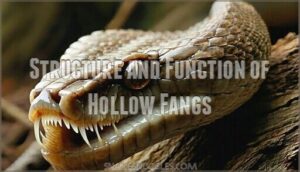This site is supported by our readers. We may earn a commission, at no cost to you, if you purchase through links.

Solenoglyphous fangs, found in vipers, fold back like switchblades and deliver venom through hollow tubes – think of nature’s hypodermic needles.
Proteroglyphous fangs in cobras and mambas stay fixed at the front, acting like built-in syringes, and Opisthoglyphous fangs sit at the back of rear-fanged snakes’ mouths, using grooves rather than hollow channels to channel venom.
Finally, aglyphous snakes lack venom delivery systems entirely, and each design reflects millions of years of evolution, perfectly matched to hunting strategies and prey types.
Understanding these structural differences reveals fascinating insights about predator-prey relationships and survival tactics.
Table Of Contents
- Key Takeaways
- Venomous Snake Fang Anatomy
- Types of Venomous Snake Fangs
- Fang Type and Venom Delivery
- Snake Fangs and Venom Composition
- Defensive Mechanisms and Fangs
- Evolutionary History of Snake Fangs
- Frequently Asked Questions (FAQs)
- What is the difference between Viper and Elapid fangs?
- What are the three types of fangs?
- How to tell the difference in venomous snakes?
- What are the different types of venomous snake fangs?
- What is the difference between elapid fangs and Viper fangs?
- Do venomous snakes have different teeth?
- How do environmental factors influence fang development?
- Can snake fangs regenerate if damaged?
- What role do fangs play aside from venom delivery?
- How do researchers study snake fang evolution in fossils?
- Conclusion
Key Takeaways
- You’ll find four distinct fang types – solenoglyphous (vipers with folding fangs), proteroglyphous (cobras with fixed front fangs), opisthoglyphous (rear-fanged snakes with grooved teeth), and aglyphous (non-venomous snakes with solid teeth)
- Hollow fangs work like nature’s hypodermic needles – they deliver venom under intense pressure through specialized muscle control, while grooved fangs channel venom along surface grooves, requiring prolonged contact
- Each fang design matches specific hunting strategies – vipers use retractable fangs for deep strikes, elapids rely on fixed fangs for quick, repeated bites, and rear-fanged species need chewing motions to inject venom effectively
- Venom composition directly influences fang structure – neurotoxic venoms pair with precise, needle-like fangs, while tissue-destroying venoms work through broader delivery systems, showing millions of years of evolutionary fine-tuning
Venomous Snake Fang Anatomy
You’ll discover that venomous snake fangs work like nature’s most sophisticated hypodermic needles, complete with hollow cores that deliver venom under intense pressure.
These remarkable structures feature beveled tips for easy penetration, specialized muscles for precise control, and flexible skull attachments that allow fangs to fold back like a switchblade when not needed, showcasing their unique ability to work with intense pressure.
Structure and Function of Hollow Fangs
Through hollow fangs, you’re witnessing nature’s precision engineering at work.
Nature’s hypodermic needles deliver death with surgical precision through millions of years of evolution.
These specialized structures operate like biological hypodermic needles, delivering venom through high-pressure injection systems.
Here’s what makes them remarkable:
- Venom injection happens instantly through hollow cores
- Pressure dynamics create forceful delivery systems
- Prey penetration occurs via needle-sharp tips
Muscle action controls fang deployment while skull flexibility enables perfect positioning for venom delivery.
Bevelled Tip and Muscle Control
Two sharp bevelled tips on venomous snake fangs slice through prey like surgical needles, ensuring perfect penetration mechanics.
You’ll find specialized muscles controlling every fang movement with strike precision that’s evolutionarily advantageous.
This muscular control system makes venom injection incredibly efficient during attacks.
Check out this handy table for more details:
Venom Sac and Fang Movement
Picture a snake’s venom storage system as nature’s perfect pharmacy. The venom sac acts like a pressurized reservoir, holding deadly cocktails until needed.
Nature’s ultimate chemical warfare arsenal—stored under pressure until the moment strikes.
Specialized muscles control fang erection and retraction with surgical precision. When striking, muscle action creates delivery pressure that forces venom through hollow fangs.
This coordinated dance between venom storage, fang movement, and muscle control guarantees efficient venom delivery every time.
Unique Skull Structure and Flexibility
Snake skulls aren’t like ours—they’re masterpieces of skull kinesis that’ll blow your mind.
This jaw mobility lets venomous species deploy fangs with surgical precision.
Here’s how cranial evolution created these bite force champions:
- Quadrate bones act like hinges, allowing massive gape
- Flexible skull joints enable independent jaw movement
- Elastic ligaments stretch dramatically during fang deployment
This snake dentition flexibility transforms fang anatomy from folded to fully extended.
Adaptations for Efficient Venom Delivery
Beyond that flexible skull structure, you’ll find venomous snake fangs have evolved remarkable adaptations that make their venom delivery incredibly efficient.
These modifications work together like a precision instrument.
- Fang morphology – Hollow fangs act like hypodermic needles, while grooved fangs channel venom along their surface
- Venom pressure – Strike precision allows controlled venom yield, from minimal defensive doses to maximum prey immobilization
- Venom injection mechanism – Different snake fang types deliver venom at ideal speeds for their hunting strategies
Larger snakes often exhibit longer fang lengths, correlating with their hunting needs.
Types of Venomous Snake Fangs
You’ll discover four distinct fang types that reveal how different snake families have evolved unique venom delivery systems over millions of years.
Each fang structure – from the hinged fangs of vipers to the fixed needles of cobras – tells a fascinating story of adaptation and survival.
Solenoglyphous Fangs in Vipers
When you encounter vipers, their solenoglyphous fangs work like nature’s hypodermic needles.
Through Viperidae evolution, these solenoglyph fangs developed hinged mechanisms for fang retraction—folding back when not striking prey.
During attacks, specialized muscles create intense venom pressure through hollow fang structure, ensuring strike precision for rapid prey immobilization.
This venom delivery system makes vipers incredibly efficient predators.
Notably, warmer climates correlate with longer viper fangs, indicating environmental influences on fang morphology.
| Feature | Description | Benefit |
|---|---|---|
| Flexibility | Hinged design | Aids in fang deployment |
| Fang Length | Varied sizes | Adapted for diverse prey |
| Delivery Angle | Precise mechanics | Maximizes venom injection |
Proteroglyphous Fangs in Elapids
Unlike their hinged viper cousins, proteroglyphous fangs in elapids stay fixed at the front of the mouth.
These hollow needles pack serious punch despite being three times shorter than viper fangs. All venomous snakes have several replacement fangs in development on each side of their mouth.
- Fixed Fang Evolution – Proteroglyph dentition evolved from rear-fanged ancestors, creating frontfanged snakes with permanent forward positioning
- Elapid Venom Delivery – High-pressure muscular contractions force venom through hollow tubes into prey with surgical precision
- Cobra Spitting Mechanism – Modified orifices in spitting cobras create pressurized venom jets for defense
- Venom Yield Variation – Multiple reserve fangs guarantee continuous delivery while accommodating different prey sizes
Opisthoglyphous Fangs in Rear-Fanged Snakes
Looking at rear-fanged snakes reveals fascinating opisthoglyphous fangs positioned behind regular teeth.
You’ll find these grooved structures in most colubrid diversity, requiring chewing action for effective venom delivery.
While venom potency stays relatively low, human risk exists with species like boomslangs, making opisthoglyph fangs uniquely adapted among snake fang types.
| Feature | Description |
|---|---|
| Location | Back of mouth, behind regular teeth |
| Structure | Grooved, not hollow like front fangs |
| Delivery Method | Requires prolonged chewing contact |
| Pressure | Low (under 5psi) compared to vipers |
Aglyphous Fangs in Non-Venomous Snakes
Aglyphous snakes’ teeth tell a fascinating story about evolution’s efficiency. These nonvenomous snakes possess solid, uniform teeth perfectly designed for gripping prey without any venom delivery system.
You’ll find this aglyphous dentition in pythons, boas, and blind snakes—species that’ve mastered constriction strategies instead of chemical warfare.
- Gripping mechanisms: Backward-curving teeth prevent prey escape during swallowing
- Constriction strategies: Powerful muscles compensate for lack of venom
- Non-venomous diet: Teeth help consume everything from rodents to birds
- Evolutionary significance: Represents ancestral snake tooth structure
- Fang morphology: Simple, cone-shaped design maximizes gripping efficiency
Aglyphous snakes demonstrate that you don’t need fancy fangs to be successful predators. Their aglyphous fangs prove sometimes the simplest solutions work best—like using a reliable wrench instead of a high-tech gadget.
Differences in Fang Structure and Function
You’ll notice that snake fang types differ dramatically in their morphology and venom delivery mechanisms.
Solenoglyphous fangs fold like switchblades for strike precision, while proteroglyphous fangs stay fixed for repeated attacks.
Opisthoglyphous fangs require chewing motions for prey immobilization.
These structural variations reflect evolutionary pressures, with each fang function perfectly matched to hunting strategies and venom injection needs.
Fang Type and Venom Delivery
You’ll discover that the relationship between fang design and venom delivery determines how effectively each snake species subdues its prey.
Different fang types—from hollow needle-like structures to grooved channels—have evolved unique mechanisms that match each snake’s hunting style and venom composition.
Hollow Fangs and High-Pressure Venom Delivery
You’ll find hollow fangs work like tiny hypodermic needles, creating incredible injection pressure that forces snake venom deep into prey tissue.
This fang anatomy design maximizes delivery speed and overcomes venom viscosity, ensuring rapid prey immobilization.
The sophisticated fang mechanics of venomous snake fangs make venom delivery remarkably efficient compared to other systems.
Grooved Fangs and Venom Flow
Unlike hollow fangs that act like hypodermic needles, grooved fangs work more like rain gutters.
You’ll find these rear-fanged delivery systems in opisthoglyphous snakes, where venom groove morphology creates channels along the fang’s surface.
The venom flow dynamics aren’t as efficient—toxins drip slowly rather than inject under pressure.
This grooved fang evolution compensates with incredibly potent venom that makes up for slower delivery rates.
Fang Type and Efficiency of Venom Delivery
Venom delivery efficiency varies dramatically between venomous snake fangs. Think of it like choosing the right tool for the job. Solenoglyphous fangs deliver massive venom quantity under high venom pressure, while proteroglyphous fangs prioritize strike precision over volume.
Different fang morphology handles prey resistance uniquely. The characteristics of fang types are crucial for effective hunting, as they determine the ideal prey size and hunting strategy.
- Hollow fangs maximize venom efficiency through pressurized injection
- Grooved fangs rely on prolonged contact for complete venom delivery
- Fang types determine ideal prey size and hunting strategy
- Venom quantity correlates directly with fang structure
- Strike precision compensates for lower pressure systems, highlighting the importance of venom delivery efficiency in the hunting process.
Adaptations for Different Prey and Environments
Venomous snake fangs showcase remarkable prey specialization and habitat influence.
Desert vipers sport long, hollow fangs for swift strikes at elusive prey, while aquatic species develop recurved teeth for gripping slippery fish.
Environmental factors drive fang morphology – from egg-eating snakes with reduced teeth to durophagous species with reinforced fangs for crushing shells.
Evolutionary pressures fine-tune these fang adaptations perfectly.
Evolutionary Advantages of Different Fang Types
Through millions of years, fang evolution shaped distinct fang types for maximum survival advantage.
Proteroglyphous fangs excel in quick strikes, while solenoglyphous fangs deliver massive venom doses.
Each fang morphology reflects prey specificity and habitat influence, with venom delivery systems perfectly matched to hunting needs.
Venom evolution created nature’s most efficient predatory tools.
Some vipers utilize solenoglyphous fang structure for this purpose.
Snake Fangs and Venom Composition
When you examine venomous snakes, you’ll discover their fangs work hand-in-hand with incredibly complex venom cocktails that can contain over 100 different toxic compounds.
The relationship between a snake’s fang structure and its venom composition isn’t just coincidence—it’s millions of years of evolutionary fine-tuning that determines whether you’re dealing with a slow-acting tissue destroyer or a lightning-fast nervous system shutdown.
Proteolytic, Hemotoxic, Neurotoxic, and Cytotoxic Venom
Understanding how different venoms work helps you appreciate nature’s deadly chemistry.
Proteolytic venom breaks down tissues, hemotoxic venom destroys blood cells, neurotoxic venom attacks nerves, and cytotoxic venom damages cells.
Each type shows unique toxicity variation and prey specificity, directly impacting antivenom efficacy.
Venom composition varies based on factors like diet and age.
These venom synergies make venomous snake fangs remarkably effective hunting tools.
Different Snake Species and Specialized Venom
Across the globe, over 600 venomous snake species craft unique chemical cocktails perfectly tuned to their prey and environment.
You’ll find remarkable Venom Specificity driving Prey Adaptation in fascinating ways:
- Golden lanceheads evolved bird-targeting toxins on isolated Snake Island
- Sea snakes develop fish-specific neurotoxins based on local prey diversity
- Saw-scaled vipers show dramatic Geographic Variation in metalloproteinases
This Evolutionary Arms Race creates specialized venom compositions.
Researchers are studying specific venom properties to understand their effects.
Venom Composition and Fang Structure
You’ll notice how venom composition directly shapes fang structure in fascinating ways.
Toxin targeting determines whether snakes develop hollow or grooved fangs, with delivery pressure systems evolving to match specific toxin cocktails.
Prey specificity drives this evolutionary relationship—neurotoxic venoms pair with fine, precise fangs, while cytotoxic mixtures work through broader, more robust delivery systems that maximize tissue contact.
Factors Affecting Venom Potency and Delivery
Several key factors determine how effectively you’ll encounter venom delivery in snake bites.
Snake age plays a vital role since younger snakes often inject more venom due to poor fang mechanics control.
- Prey size influences venom yield – larger prey requires more venom for effective immobilization
- Environmental factors affect venom potency – temperature and humidity impact venom concentration
- Injection method varies by fang structure – hollow fangs create higher venom pressure than grooved ones
- Snake age determines delivery precision – experienced adults control venom release more efficiently
Medical Significance of Understanding Venom Composition
When you’re dealing with snake venom, antivenom development hinges on precise toxin identification.
Clinical toxicology researchers analyze venom composition to create targeted treatments, while bite treatment protocols rely on understanding specific snake venom components.
This venom research directly improves snakebite treatment outcomes and advances medical applications for emergency care.
Researchers often require specific materials for analysis.
Defensive Mechanisms and Fangs
You’ll find that venomous snakes don’t just use their fangs for hunting – they’re equally important as defensive weapons when these reptiles feel threatened.
Different fang types offer unique advantages for protection, from spitting cobras that can accurately project venom up to eight feet away to rear-fanged species that must deliver a sustained bite to inject their defensive toxins.
Spitting Cobras and Venom Projection
Spitting cobras turn their proteroglyph fangs into precision weapons, achieving remarkable spitting accuracy at distances up to eight feet.
You’ll witness these elapids using specialized muscle control for eye targeting, ejecting venom through modified fang orifices.
Their venom mutations enhance cytotoxic effects, making venom projection a formidable defensive strategy that’s evolved independently across multiple lineages.
Understanding global venomous snake distribution helps contextualize the evolution of these unique defense mechanisms.
Rear-Fanged Snakes and Defensive Behavior
Unlike spitting cobras that launch venom from a distance, rear-fanged snakes with opisthoglyphous fangs take a different approach to defensive behavior.
You’ll find these Colubrid species rely on theatrical performances rather than their mild venom for protection.
- Chewing strikes require prolonged contact for venom delivery through their rear-positioned fangs
- Venom metering produces weak doses that pose minimal human risk compared to front-fanged species
- Colubrid defense emphasizes intimidation displays and mimicry over their inefficient snakebite mechanism
Fangs as Defensive Structures
While rear-fanged snakes rely on prolonged contact, most venomous species use fangs as immediate defensive weapons.
When you encounter a threatened snake, you’ll notice defensive strikes aren’t about feeding—they’re pure predator avoidance.
These threat display behaviors conserve venom expenditure while maximizing intimidation through fang durability and precision venom delivery.
| Defense Type | Primary Function |
|---|---|
| Warning Strike | Intimidate without contact |
| Dry Bite | Conserve venom reserves |
| Full Envenomation | Last resort protection |
Adaptations for Self-Defense and Prey Capture
You’ll notice how fang deployment serves dual purposes through millions of years of venom evolution.
Strike precision allows snakes to deliver targeted defensive biting when threatened, while the same system enables efficient prey immobilization.
Different venomous snake fang types showcase remarkable fang variations—from hinged vipers that fold back like switchblades to fixed cobra fangs.
Each snake’s venom delivery system reflects perfect adaptation for survival.
Unique Features of Venomous Snake Fangs
Nature’s engineering shines through venomous snake fang types, where each species showcases remarkable adaptations.
You’ll discover that fang evolution has produced incredibly specialized tools for survival and hunting success.
Consider these fascinating features:
- Venom pressure systems deliver toxins with surgical precision, matching prey specificity requirements perfectly
- Strike precision mechanisms guarantee accurate targeting through flexible skull adaptations and muscle control
- Fang shedding cycles maintain sharp, effective venom delivery systems throughout the snake’s lifetime
These snake fangs represent millions of years of refinement, with fang structure perfectly matched to each species’ hunting style.
Evolutionary History of Snake Fangs
You’ll find that snake fangs didn’t just appear overnight—they evolved through millions of years of trial and error, with fossil evidence showing how simple grooved teeth gradually transformed into the sophisticated hollow injection systems we see today.
The geographic spread of venomous snakes tells a fascinating story of adaptation, where different fang types emerged in response to local prey and environmental challenges, basically turning these reptiles into nature’s most efficient liquid delivery specialists.
Fossil Evidence and Transitional Fang Structures
Ancient snake fossils tell a remarkable story about fang evolution timeline and transitional fang morphology.
Fossil evidence from Uatchitodon reveals grooved teeth that gradually developed into hollow canals, showing clear venom delivery origins.
These discoveries help scientists understand early snake diets and how fang structure comparison between extinct and modern species demonstrates nature’s incredible evolutionary experimentation with venom systems.
Geographic Distribution of Venomous Snakes
You’ll find venomous snakes on every continent except Antarctica, with Global Snake Hotspots in tropical regions.
Australia boasts the highest diversity, while Climate Impact drives Venomous Range Shifts northward.
Habitat Specificity shapes snake distribution—desert vipers thrive in arid zones, while forest cobras prefer humid environments.
Invasive Snake Species like Burmese pythons disrupt local ecosystems, showcasing how environmental factors influence biogeography and ecological roles.
Evolutionary Advantage of Hollow Fangs
Hollow fangs transformed venomous snakes into precision predators through revolutionary skull evolution.
You’ll see three key advantages that drove viper success:
- Prey Immobilization: Rapid injection paralyzes victims instantly
- Venom Efficiency: Zero waste during fang evolution’s perfection
- Fang Efficiency: Hollow design maximizes venom delivery pressure
This venomous snake fang types innovation gave snakes unmatched hunting prowess across diverse ecosystems.
Natural Selection and Adaptation in Snake Fangs
You’ll see how evolutionary pressures shaped snake fangs when prey developed resistance mechanisms.
Natural selection favored snakes with enhanced venom potency and optimized fang morphology.
As prey adapted defensive strategies, fang evolution accelerated through habitat influence and specific hunting demands.
Different environments created unique evolutionary pressures, driving fang design innovations, which led to a constant arms race between predator and prey adaptation.
This constant refining venom delivery systems continues today.
Ongoing Research and New Insights Into Snake Fang Evolution
Scientists today are unraveling fang evolution timelines through cutting-edge biomechanical fang studies and venom gene origins research.
You’ll find researchers tracking how environmental influences shaped venomous snake fang types over millions of years.
Studying fang evolutionary products can provide further insights.
Future fang research promises exciting discoveries about fang development mechanisms, revealing how nature’s perfect venom delivery systems evolved through remarkable adaptations.
Frequently Asked Questions (FAQs)
What is the difference between Viper and Elapid fangs?
Unlike folding pocket knives versus fixed blades, viper fangs hinge back when not needed, while elapid fangs stay permanently extended.
You’ll find vipers use hollow, retractable fangs for deep strikes, but elapids rely on shorter, fixed fangs for quick bites.
What are the three types of fangs?
Venomous snakes use three distinct fang types: proteroglyphous (fixed front fangs in cobras), solenoglyphous (hinged hollow fangs in vipers), and opisthoglyphous (rear-grooved fangs requiring chewing).
How to tell the difference in venomous snakes?
You’ll spot differences by examining fang placement and structure.
Vipers have long, hinged fangs that fold back, elapids display short, fixed front fangs, while rear-fanged colubrids position grooved fangs toward their mouth’s back, showcasing a unique aspect of their mouth’s anatomy.
What are the different types of venomous snake fangs?
Like nature’s toolkit holds different keys for different locks, you’ll find three main venomous fang types.
Solenoglyphous fangs in vipers that fold back like switchblades, proteroglyphous fangs in elapids that stay fixed forward, and opisthoglyphous rear fangs in colubrids requiring a chewing motion.
What is the difference between elapid fangs and Viper fangs?
Elapid fangs are proteroglyphous—fixed, short, and needle-like at the front of their mouths.
Viper fangs are solenoglyphous—long, hollow, and hinged, folding back when you’re not looking at them in action.
Do venomous snakes have different teeth?
You’ll discover venomous snakes possess specialized fangs rather than regular teeth. These hollow or grooved structures inject venom efficiently, while non-venomous snakes simply use standard teeth for gripping prey.
How do environmental factors influence fang development?
Environmental factors shape your snake’s fang development through prey availability, habitat pressure, and climate conditions.
You’ll notice larger fangs in species hunting bigger prey, while dense vegetation favors shorter, more maneuverable fangs for efficient strikes, influenced by habitat pressure.
Can snake fangs regenerate if damaged?
Think your snake’s fang broke like a human tooth? You’re in luck!
Snake fangs regenerate naturally every few months, constantly replacing themselves through specialized dental tissues that guarantee continuous fang renewal for superior venom delivery.
This process ensures superior venom delivery, making it a unique and efficient system for snakes.
What role do fangs play aside from venom delivery?
Beyond venom delivery, you’ll find fangs serve as essential gripping tools that help snakes secure struggling prey during strikes. They anchor victims while constriction or venom takes effect, preventing escape.
How do researchers study snake fang evolution in fossils?
Actions speak louder than words" when studying fossilized fangs, since researchers can’t observe living behavior.
You’ll examine preserved skull structures, measure fang placement and groove patterns, then compare these anatomical features across different geological time periods to trace evolutionary changes.
Conclusion
Surprisingly, you’ve now discovered that nature’s most sophisticated injection systems aren’t found in medical labs but slithering through grass and coiled in trees.
Understanding venomous snake fang types differences transforms these creatures from simple predators into marvels of biological engineering. Each fang design—whether solenoglyphous, proteroglyphous, or opisthoglyphous—represents millions of years of refinement.
You’ll appreciate how these specialized structures perfectly match hunting strategies and prey preferences, revealing evolution’s incredible precision in crafting deadly efficiency.
- https://blog.wcs.org/photo/2015/03/11/fang-facts-snake/
- https://reptilesmagazine.com/fang-facts-of-vipers-elapids-and-colubrids/
- https://australian.museum/learn/animals/reptiles/fangs-of-deadly-venomous-snakes/
- https://bushguide101.com/snake-teeth-and-fangs/
- https://snakesarelong.blogspot.com/2013/09/basics-of-snake-fangs.html




















